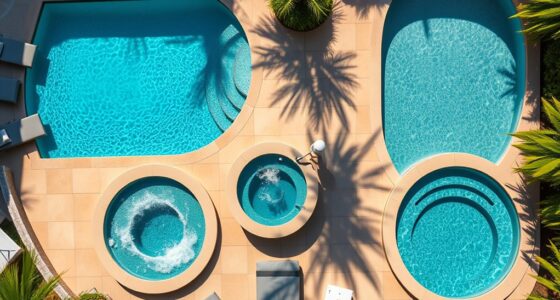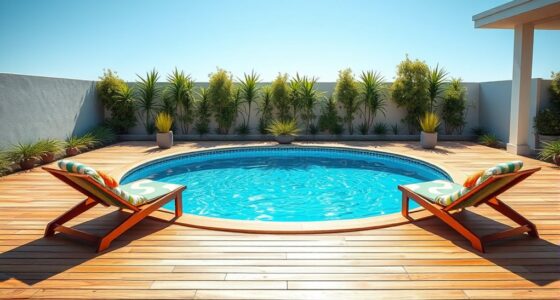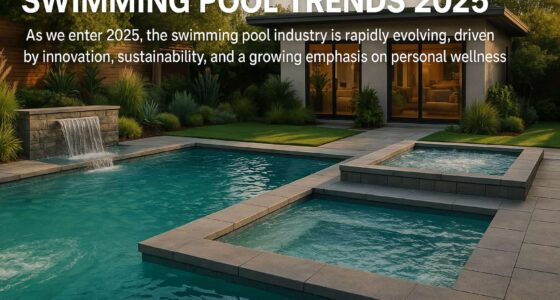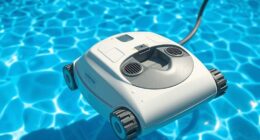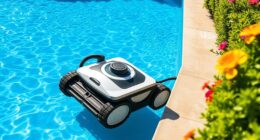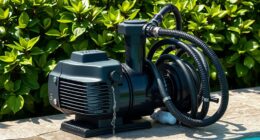When comparing lap pools and plunge pools, consider your needs. Lap pools are perfect for serious swimmers, offering long, narrow spaces for fitness. They can be costly and require regular maintenance. Plunge pools, on the other hand, are smaller and designed for relaxation, making them great for tight spaces. They’re also more affordable and easier to maintain. If you’re looking for more details on installation, costs, and aesthetic choices, there’s plenty more to explore!
Key Takeaways
- Lap pools are designed for serious swimming and fitness, while plunge pools focus on relaxation and leisure.
- Lap pools require larger spaces (at least 40 feet long), whereas plunge pools fit in smaller backyards.
- The cost of lap pools ranges from $40,000 to $80,000, while plunge pools are generally more affordable, ranging from $15,000 to $40,000.
- Lap pools typically have a long, narrow design, enhancing aesthetic appeal, while plunge pools offer a cozy, intimate atmosphere.
- Maintenance requirements differ; lap pools need more frequent cleaning due to larger water volume compared to plunge pools.
Overview of Lap Pools
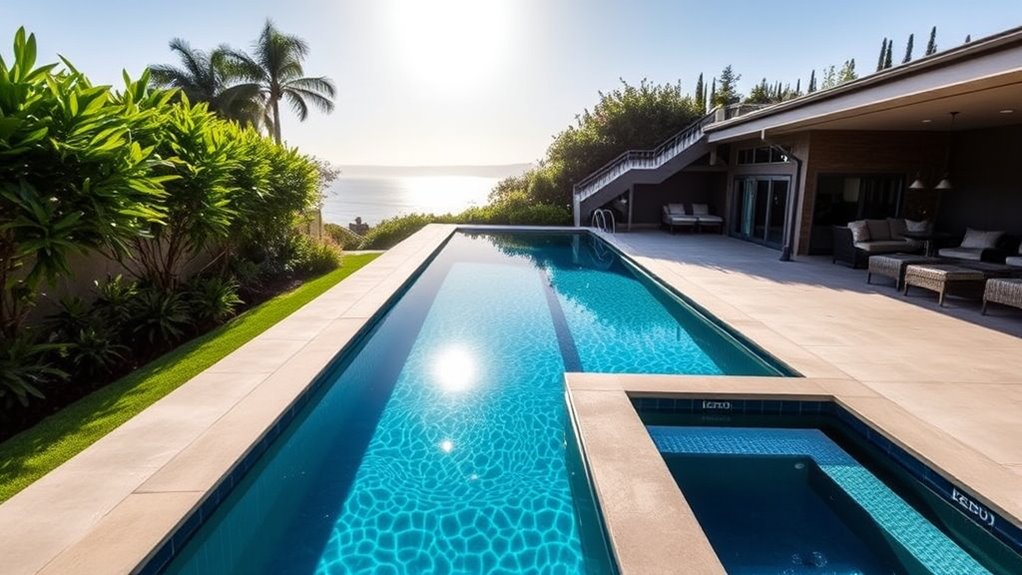
When you think about enhancing your fitness routine at home, lap pools stand out as a practical choice. Designed primarily for swimming laps, these long, narrow pools typically range from 30 to 75 feet in length, making them perfect for effective workouts.
You can install them as in-ground or above-ground options, depending on your space and budget. Crafted from materials like concrete, vinyl, or acrylic, lap pools offer customization with features like heating or resistance currents.
They maximize space, especially in smaller yards, and add aesthetic appeal to your outdoor area. While they require regular maintenance and may incur heating costs, lap pools are a worthwhile investment for serious swimmers focused on fitness and health.
Overview of Plunge Pools
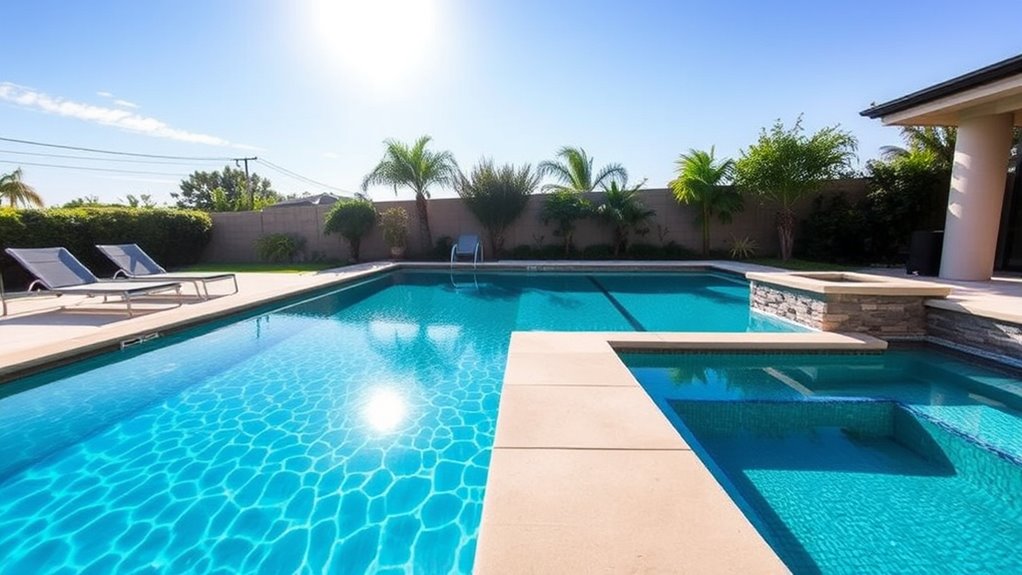
Plunge pools offer a revitalizing escape for relaxation and leisure, serving as a perfect addition to your outdoor space.
Designed primarily for lounging, they typically feature a uniform depth of 5-7 feet, making them great for standing or submerging. Their compact size fits well in smaller backyards, allowing for versatility in installation, whether above ground or in-ground.
Plunge pools, with their uniform depth of 5-7 feet, offer a perfect lounging oasis for any backyard space.
You can enhance your plunge pool experience with jets for a spa-like feel or use it as a hot tub during colder months. Plus, they’re cost-effective to heat and maintain, requiring fewer chemicals and accessories compared to larger pools.
If you’re looking for a low-maintenance, eco-friendly option, plunge pools are an excellent choice.
Design Features of Lap Pools
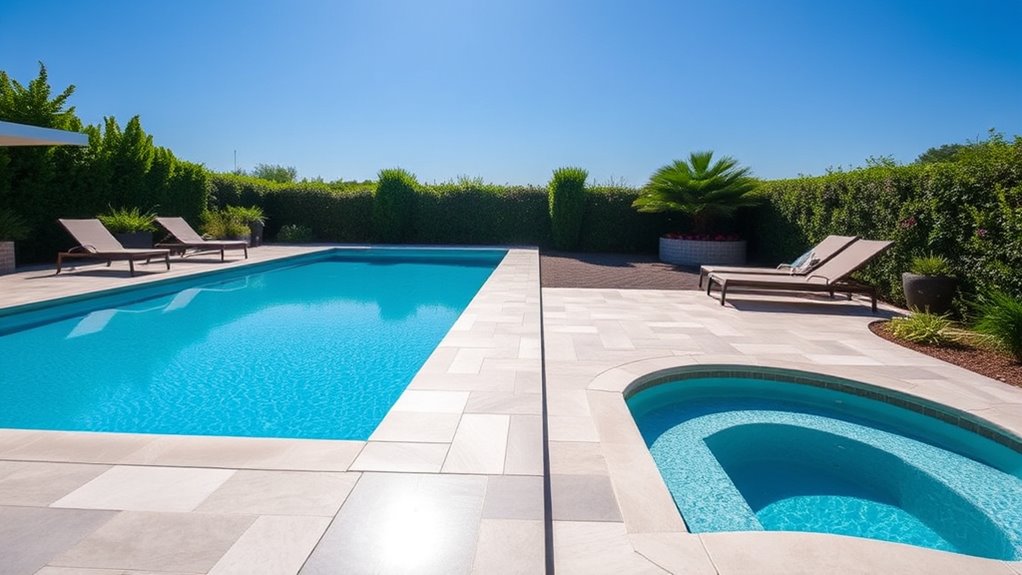
Lap pools are designed with the serious swimmer in mind, offering a streamlined space that maximizes efficiency and functionality. Typically long and narrow, these pools range from 30 to 75 feet, providing an unobstructed lane for smooth swimming.
You can customize your lap pool with features like a spa, tanning ledges, or even water fountains for aesthetics. They can be constructed with durable materials such as concrete or galvanized steel, ensuring longevity.
Additionally, many lap pools include heating systems for year-round enjoyment and machines that create artificial currents, allowing you to swim in place. This perfect blend of functionality and design makes lap pools ideal for both serious training and leisurely swims. To enhance the overall outdoor experience, consider incorporating natural materials that complement the pool’s design and surrounding landscape.
Design Features of Plunge Pools

While many people seek spacious pools for swimming and recreation, plunge pools offer a compact yet versatile alternative that fits perfectly into smaller spaces.
These pools can be designed with built-in benches and tanning ledges, enhancing your relaxation experience. You might also enjoy therapeutic benefits, as some models include hydrotherapy features to soothe aches and pains.
Plus, certain plunge pools can double as hot tubs, offering year-round enjoyment. With swim tethers, you can still get your exercise despite the compact size.
Their low maintenance and small footprint make them ideal for tight yards, while aesthetic options like wood decks or water features can seamlessly integrate with your outdoor living area.
Installation and Maintenance Comparison
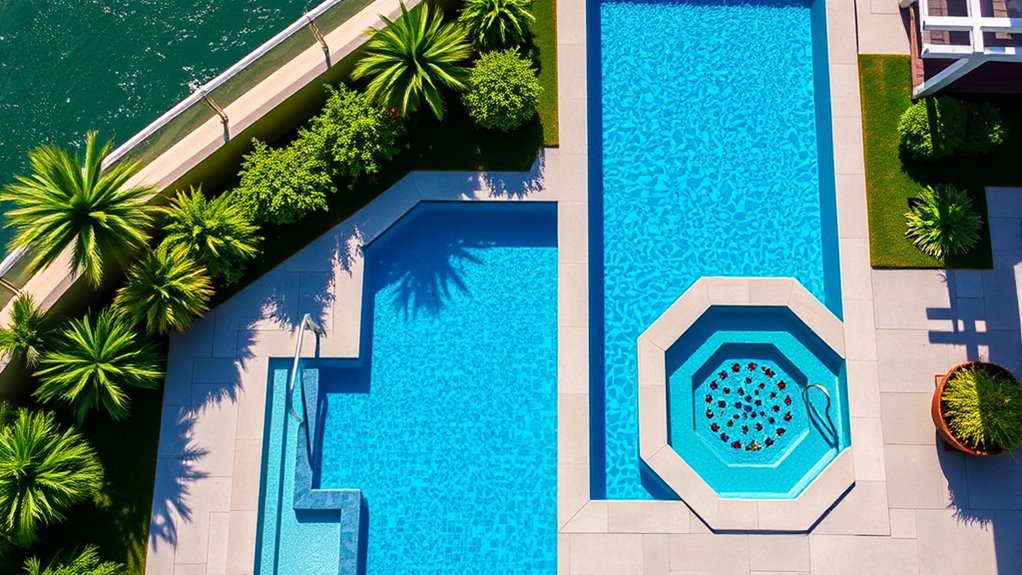
When considering the installation and maintenance of pools, you’ll find that lap and plunge pools differ in several key aspects.
Lap pools need long, narrow spaces, typically around 40 feet, while plunge pools can fit in smaller areas. Both types can be installed in-ground, but you’ll require permits based on local building codes.
Lap pools require long, narrow spaces of about 40 feet, whereas plunge pools are suited for smaller areas.
Maintenance-wise, both pools need regular chemical checks and efficient pumps and filters. However, lap pools may need cleaning more frequently due to their larger water volume.
Automated cleaning systems can help, but regular surface checks are essential to prevent leaks and damage.
Ultimately, both types demand commitment, but understanding their differences can simplify your decision-making process.
Cost Analysis of Lap Pools

Investing in a lap pool can set you back anywhere from $40,000 to $80,000, depending on various factors. Most homeowners typically spend around $60,000 for a lap pool, but costs can vary widely.
Above-ground models start at about $4,000, while in-ground options range from $25,600 to over $100,000. Size and features play a significant role in pricing; for instance, a standard 40-foot lap pool costs around $45,000, while larger pools may reach $400,000 or more.
Additional factors like materials, labor costs, and custom features can further impact your budget. If you’re on a tighter budget, consider an above-ground pool as a cost-effective alternative to a traditional lap pool.
Cost Analysis of Plunge Pools

Lap pools can be a significant investment, with costs often reaching up to $80,000.
In contrast, plunge pools are generally more affordable, ranging from $15,000 to $40,000, with an average around $20,000.
Inground plunge pools may cost between $10,000 and $70,000, while above-ground options can be as low as $3,000.
Factors like size, shape, and materials impact costs; larger or custom designs will increase your budget.
Additionally, installation location and necessary permits can add to expenses.
Small plunge pools typically cost $10,000 to $15,000, while larger ones run from $20,000 to $30,000.
Choosing between above-ground and inground options often depends on your budget and aesthetic preferences.
Recreational Uses of Lap Pools
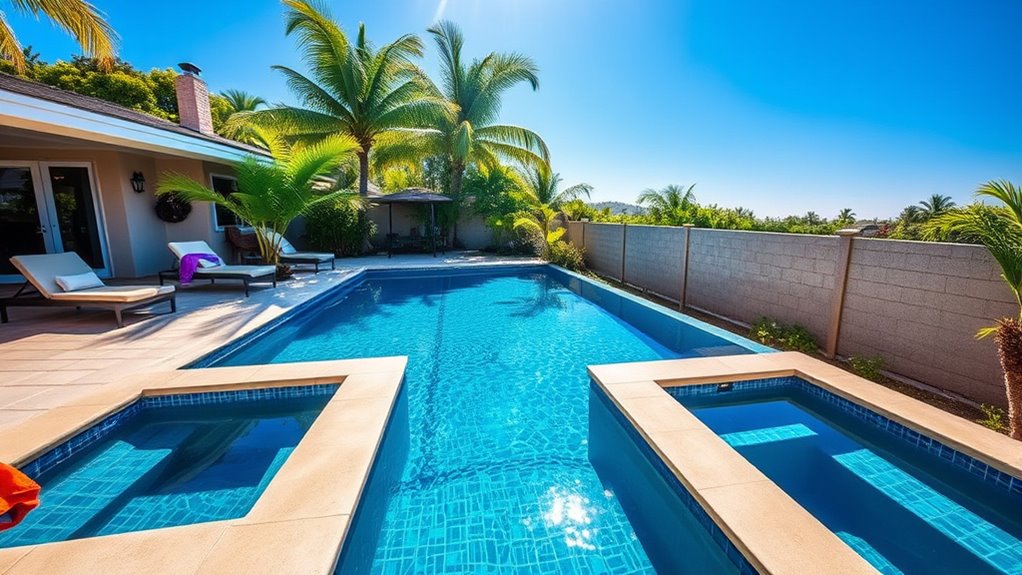
Swimming provides an excellent way to enjoy recreation, and lap pools are perfect for this purpose. You can plunge into a rigorous fitness training routine, boosting your cardiovascular health and building muscle strength.
As you consistently swim laps, you’ll enhance your endurance, which is essential for competitions and overall fitness. Plus, lap pools are low-impact, making them ideal if you have joint issues. Additionally, lap pools can be designed with various features to cater to your specific swimming needs.
If you’re a competitive swimmer, these pools allow you to practice techniques and improve your speed effectively. With features like starting blocks and spa jets, your swim can be both intense and relaxing. Additionally, incorporating sustainable practices into your pool maintenance can further enhance your eco-friendly lifestyle.
Recreational Uses of Plunge Pools
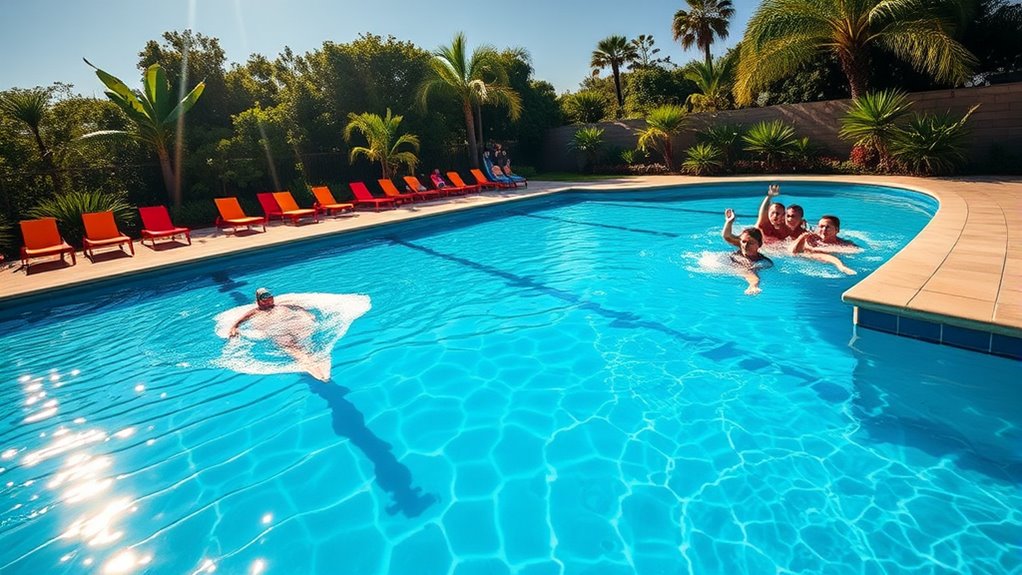
Plunge pools offer a unique recreational experience, perfect for relaxation and social gatherings. You can enjoy cold water therapy, which aids muscle recovery and boosts immunity.
These pools are great for low-impact exercises, making them suitable if you have injuries or chronic pain. Water aerobics in a plunge pool provides an excellent cardio workout while supporting your weight loss efforts.
Plus, their compact design allows you to integrate them with saunas or fire pits for a complete wellness experience. The invigorating cold water not only improves circulation but also enhances sleep quality and reduces stress.
With all these benefits, plunge pools truly elevate your outdoor leisure time.
Space Considerations for Both Pool Types
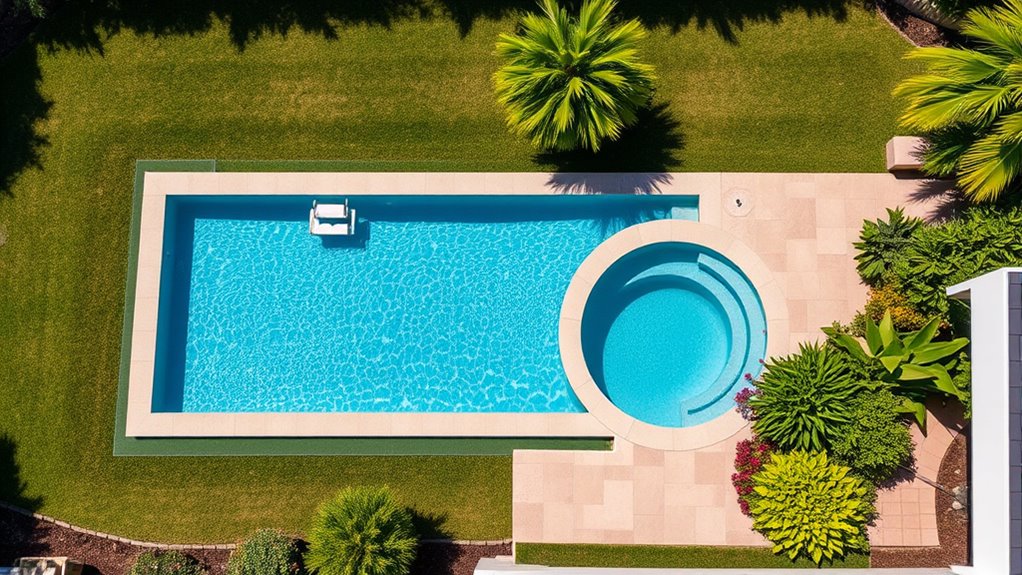
When considering space for your new pool, it’s essential to understand the distinct requirements of lap pools and plunge pools.
Lap pools, typically ranging from 30 to 75 feet long and 6 to 10 feet wide, require at least 38 by 16 feet for installation, including deck space. Their long, narrow design makes them ideal for tight urban settings.
In contrast, plunge pools are smaller, often circular or square, focusing on depth rather than length. While lap pools maximize swimming area, plunge pools cater to quick dips and relaxation.
Consider access and parking space around both types for functionality and aesthetics, ensuring you create a beautiful and practical outdoor oasis.
Frequently Asked Questions
What Are the Best Materials for Building Each Pool Type?
When building a pool, you’ll want to choose materials based on your design and budget.
For durability, concrete or gunite is excellent, providing strength and longevity. If you prefer affordability and smoothness, consider vinyl liners for in-ground options.
For plunge pools, fiberglass offers a lightweight, cost-effective solution, while concrete suits custom designs.
Don’t forget to include waterproofing materials and coping for both types to enhance durability and aesthetics.
How Do Climate Conditions Affect Pool Choices?
When choosing a pool, it’s like picking a partner; the right match depends on your environment.
Climate conditions play a huge role in your decision. If you live in a hot, dry area, you’ll need to think about water loss and maintenance.
In cooler climates, heating costs might be a concern.
Ultimately, understanding how your local weather impacts your pool choice guarantees you create a rejuvenating oasis that suits your lifestyle.
Can I Install a Pool Indoors?
Yes, you can install a pool indoors!
However, you’ll need to contemplate space, structural support, and ventilation. Indoor pools often require more room and stronger foundations than you might expect.
You’ll also have to manage air quality and humidity, which means investing in proper heating and cooling systems.
While upfront costs can be significant, the year-round access to swimming can make it worthwhile for both fitness and relaxation.
What Safety Features Are Recommended for Both Pool Types?
When you’re considering safety features for your pool, it’s important to prioritize proper fencing, alarms, and covers.
Install a fence that’s at least four feet high with self-closing gates to keep kids safe. Use surface wave sensors and threshold alarms for added security.
Don’t forget about pool covers, which prevent accidental falls and keep debris out.
Regular maintenance and adult supervision are also vital to guarantee a safe swimming environment for everyone.
Are There Any Zoning Regulations for Installing Pools?
Yes, there are zoning regulations for installing pools that you need to take into account.
Many jurisdictions require pools to be at least 10 feet away from property lines and other structures. You usually can’t place a pool in the front yard, and they must avoid utility easements.
Additionally, you’ll need to obtain permits and make sure your pool meets local safety standards before use.
Always check local ordinances to avoid any surprises!
Conclusion
Whether you’re drawn to the endless swim of a lap pool or the invigorating dip of a plunge pool, both options offer unique benefits that can transform your backyard. Imagine stepping out into your own oasis for exercise or relaxation, just as you finish a long day. The choice between them hinges on your lifestyle, space, and budget. Whichever you choose, you’re one step closer to creating the perfect retreat right at home. Why not plunge in?


